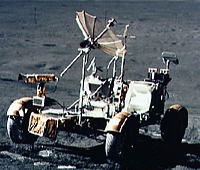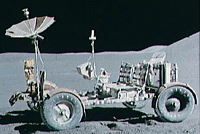How NASA Moved Around on the Moon
 |
During the Apollo 15, 16, 17 missions lunar rovers like the one shown here were used to help astronauts move around on the moon. They are electric vehicles that were designed to be strong, light weight and very reliable. Each rover, also known as moon buggies, had a mass of 210kg. On earth 210kg would equal about 450lbs and only 75lbs on the moon! Once one the moon, they could carry a 490kg payload. The rover was made of aluminum and titanium, two very light weight but strong metals. |
| Getting the rover to the moon was a tricky endeavor. The moon buggy had to be small enough to fit in the lunar lander but large enough to handle the craters and boulders that cover the surface of the moon. In the end the engineers designed a rover that could be folded up inside the lander and then easily assembled by the astronauts on the moon. The rovers allowed the astronauts to travel distances of up to 5 km from the landing site. In the rovers they could collect data and explore a greater area of the moon than they could on foot. The rovers were left on the moon by the astronauts and will probably remain there for thousands of years. |  |